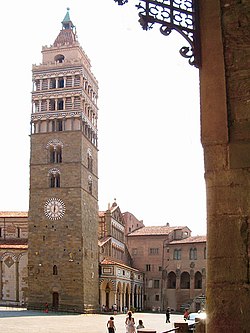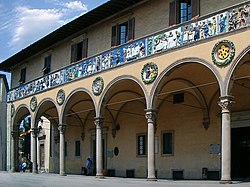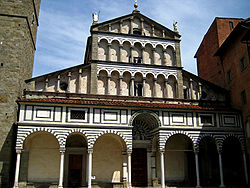Pistoia
Pistoia | |
|---|---|
| Comune di Pistoia | |
 The Bell Tower of the Cathedral in Piazza Duomo. | |
| Coordinates: 43°56′N 10°55′E / 43.933°N 10.917°E | |
| Country | Italy |
| Region | Tuscany |
| Province | Pistoia (PT) |
| Frazioni | see list |
| Government | |
| • Mayor | Renzo Berti (from May 2002) |
| Area | |
| • Total | 236 km2 (91 sq mi) |
| Elevation | 65 m (213 ft) |
| Population | |
| • Total | 89,418 |
| • Density | 380/km2 (980/sq mi) |
| Demonym | Pistoiesi |
| Time zone | UTC+1 (CET) |
| • Summer (DST) | UTC+2 (CEST) |
| Postal code | 51100 |
| Dialing code | 0573 |
| Patron saint | St. Jacopo |
| Saint day | July 25 |
| Website | www.comune.pistoia.it |



Pistoia is a city in the Tuscany region of Italy, the capital of a province of the same name, located about 30 km west and north of Florence.
History
Pistoria (in Latin other possible spellings are Pistorium or Pistoriae) was centre of Gallic, Ligurian and Etruscan settlements before becoming a Roman colony in the 6th century BC, along the important road Via Cassia: in 62 BC the demagogue Catiline and his fellow conspirators were slain nearby. From the 5th century the city was a bishopric, and during the Lombardic kingdom it was a royal city and had several privileges. Pistoia's most splendid age began in 1177 when it proclaimed itself a free commune: in the following years it became an important political centre, erecting walls and several public and religious buildings.
In 1254 the Ghibelline Pistoia was taken over by Guelph Florence, but supposedly resulted in the division of the Guelphs into "Black" and "White" factions. Pistoia remained a Florentine holding except for a brief period in the 14th century, when Castruccio Castracani captured it for Lucca, and was officially annexed to Florence in 1530. During the 14th century Ormanno Tedici was one of the Lords of the city.
In 1786 a famous Jansenist episcopal synod was convened in Pistoia.
Dante mentioned in his Divina Commedia the free town of Pistoia as the home town of Vanni Fucci, who is encountered in Inferno tangled up in a knot of snakes while cursing God, and Michelangelo called the Pistoiesi the "enemies of heaven".
Pistoia lent its name to the pistol[3], which it started manufacturing in the 16th century. But today it is also notable for the extensive garden nurseries spreading around it. Consequently, Pistoia is also famous for its flower markets, as is the nearby Pescia.
Main sights
Although not as visited as other towns in Tuscany, mostly due to the industrial environs, Pistoia presents a well-preserved and charming medieval city inside the old walls.
Piazza del Duomo
The large Piazza del Duomo is lined with attractive original buildings as the Palazzo del Comune and the Palazzo del Podestà: it is the setting (in July) of the Giostra dell'Orso ("Bear Joust"), when the best horsemen of the districts of the town tilt with lances at a target held up by a dummy shaped like a bear.
The original Cathedral of San Zeno (5th century) burned down in 1108, but was rebuilt during the following century, and received incremental improvements until the 17th century. The façade has a prominent Romanesque style, while the interior received heavy Baroque additions which were removed during the 1960s. Its outstanding feature is the Altar of St James, an exemplar of the silversmith's craft begun in 1287 but not finished until the 15th century. Its various sections contain 628 figures, the total weighing nearly a ton. The Romanesque belfry, standing at some 67 m, was erected over an ancient Lombard tower.
In the square is also the 14th century Baptistry, in Gothic style, with white-green marble decorations.
The Palazzo dei Vescovi ("Bishops' Palace") is characterized by a Gothic loggiato at the first floor. The Tower of Catilina is from the High Middle Ages, and stands 30 m high.
Religious buildings
This section needs expansion. You can help by adding to it. (June 2008) |
- Madonna dell'Umiltà (1509), finished by Giorgio Vasari with a 59 m-high cupola. The original project was by Giuliano da Sangallo, but works were begun in 1495 by Ventura Vitoni. The dome was commissioned by Cosimo I de' Medici to Vasari, the lantern begin completed in 1568 adn the church consecrated in 1582. In the apse is a painting by Bernardino del Signoraccio (1493).
- the Baroque Santissima Annunziata, famous for its Chiostro dei Morti ("Dead's Cloister").
- the Baroque Santissima Annunziata, famous for its Chiostro dei Morti ("Dead's Cloister").
- San Bartolomeo in Pantano (12th century).
- San Giovanni Battista (15th century). Damaged during World War II bombardments, it is now used as an exhibition center.
- San Giovanni Battista al Tempio (11th century), owned for a while by the Templar and then by the Hospitaller Knights.
- San Benedetto (14th century, restored in 1630). It houses a 1390 Annunciation by Giovanni Bartolomeo Cristiani, a 16th century Forentine school St. Benedict with the Redeemer and, in the cloister, Histories of the Order of the Knights of St. Benedict by Giovan Battista Vanni (1660).
- San Domenico.
- Franciscan church of San Francesco (begun in 1289). It has an unfinished façade with bichrome marble decoration. It has frescoes with 'Histories of St. Francis in the main chapel and other 14th-15th centuries frescoes.
- The Romanesque San Giovanni Fuoricivitas (12th-14th century).
- San Leone, built in the 14th century but enlarged in the 16th-18th centuries. Its Baroque-Roccoco interior houses some notable canvasses by artists such as Giovanni Lanfranco, Stefano Marucelli and Vincenzo Meucci.
- Santa Maria delle Grazie.
- Santa Maria in Ripalta, mentioned from the 11th century. It houses a large Ascention fresco in the apse, attributed to Manfredino d'Alberto (1274).
- San Paolo.
- San Pier Maggiore.
- Pieve di Sant'Andrea, housing Giovanni Pisano's Pulpit of St. Andrew.
- The ancient Pieve of San Michele in Groppoli, in the neighbourhood of the city.
- La Vergine.
Others
- The 14th century walls. These had originally four gates, Porta al Borgo, Porta San Marco, Porta Carratica and Porta Lucchese, all demolished at the beginning of the 20th century.
- Ospedale del Ceppo (13th century).
- Palazzo del Balì
- The Monument in Honour of Brazilians (Soldiers and Pilots) killed in action on Italian Campaign (World War II)
- The Medici Fortress of Santa Barbara, built a first time in 1331 century by the Florentines, but destroyed by the Pistoiese citizens in 1343. It was rebuilt by order of Cosimo I de' Medici from 1539, and later enlarged by Bernardo Buontalenti. It sustained one single siege by the Barberini troops in 1643, before being disarmed by Grand Duke Peter Leopold in 1734. Later it was used as barracks and mlitary jail, while now houses cinema shows in summer.
Notable people
- Enrico Betti
- Mauro Bolognini
- Cino da Pistoia
- Pope Clement IX
- Ippolito Desideri
- Massimo Freccia (Valdibure)
- Licio Gelli
- Marino Marini
- Giovanni Michelucci
- Filippo Pacini
Badia a Pacciana, Baggio, Bargi, Barile, Bonelle, Bottegone, Campiglio Germinaia, Canapale, Candeglia, Capostrada, Case Nuove di Masiano, Castagno di Piteccio, Chiazzano, Chiesina Montalese, Chiodo, Cignano, Cireglio, Collina, Corsini Bianchi, Corsini Neri, Fabbrica, Gello, Iano, Le Fornaci, Le Grazie, Le Piastre, Le Pozze, Le Querci, Lupicciano, Masiano, Masotti, Nespolo, Orsigna, Piazza, Piestro, Piteccio, Piuvica, Pontelungo, Pontenuovo, Pracchia, Pupigliana, Ramini, Sammommè, San Biagio, San Felice, San Rocco, Sant'Agostino, Sant'Alessio in Bigiano, Santomato, Saturnana, Spazzavento, Stazzana, Torbecchia, Valdibrana, Vicofaro, Villa di Baggio, Villanova di Valdibrana.
Twin towns
Pistoia is twinned with:
Footnotes
- ^ "Superficie di Comuni Province e Regioni italiane al 9 ottobre 2011". Italian National Institute of Statistics. Retrieved 16 March 2019.
- ^ "Popolazione Residente al 1° Gennaio 2018". Italian National Institute of Statistics. Retrieved 16 March 2019.
- ^ Online Etymology Dictionary
Bibliography
- David Herlihy. Medieval and Renaissance Pistoia: the social history of an Italian town. New Haven e Londra, Yale University Press, 1967.



